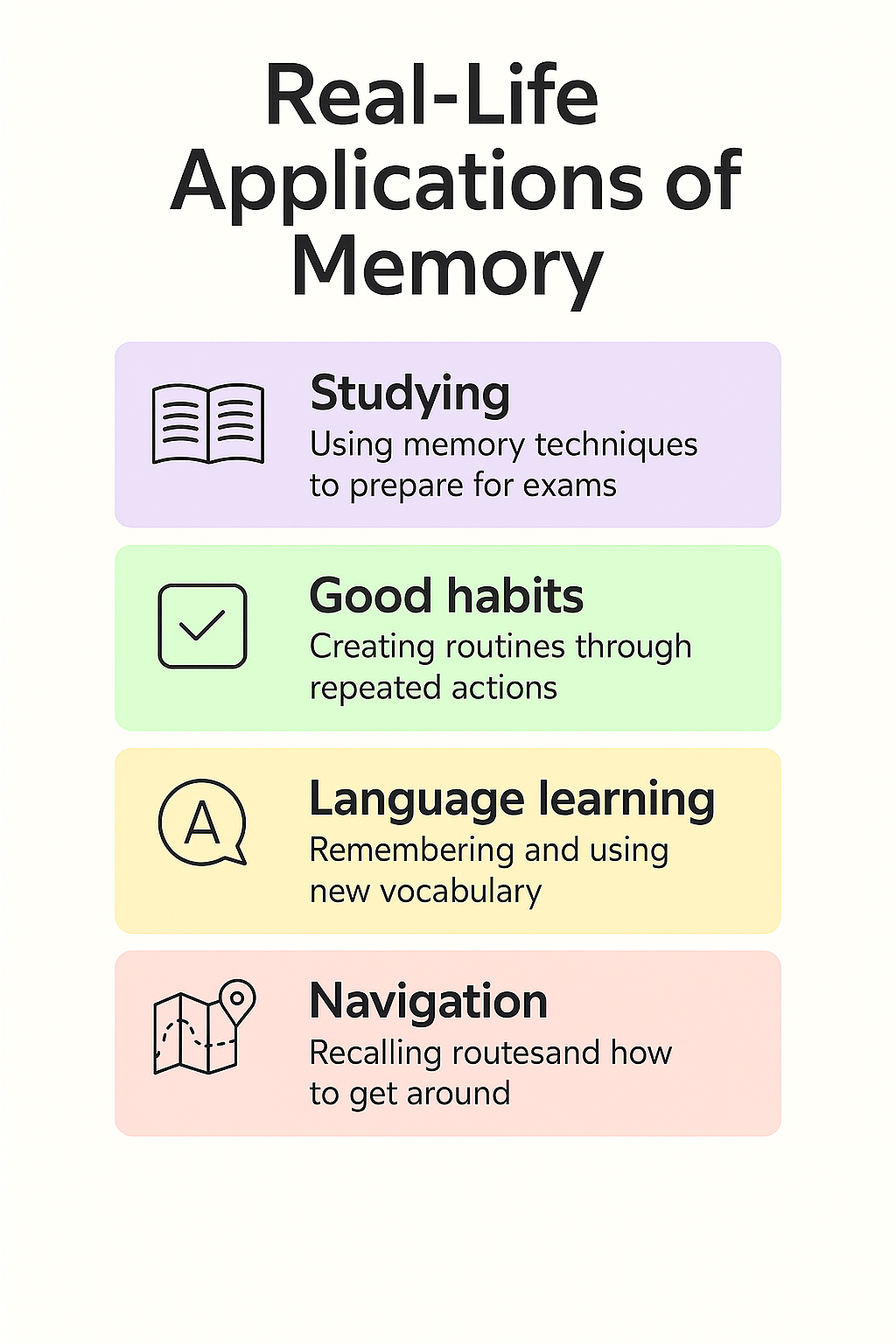Memory in Psychology
Memory in psychology is the foundation of our identity. From remembering your name to recalling your childhood stories, every experience we process is stored and retrieved through memory. But have you ever wondered how your brain remembers, or why sometimes it forgets?
In this blog, we’ll explore memory in psychology — its definition, steps, types, and how you can enhance it. This is not just theory, but a practical guide to understand your mind.
What is Memory in Psychology?
In psychology, memory is the cognitive process by which we encode, store, and retrieve information. It allows us to learn, adapt, and interact with the world.
Famous psychologist Richard Atkinson described memory as “a mental process that enables organisms to retain and retrieve information.”
The 3 Stages of Memory in Psychology
Every memory goes through three basic processes.
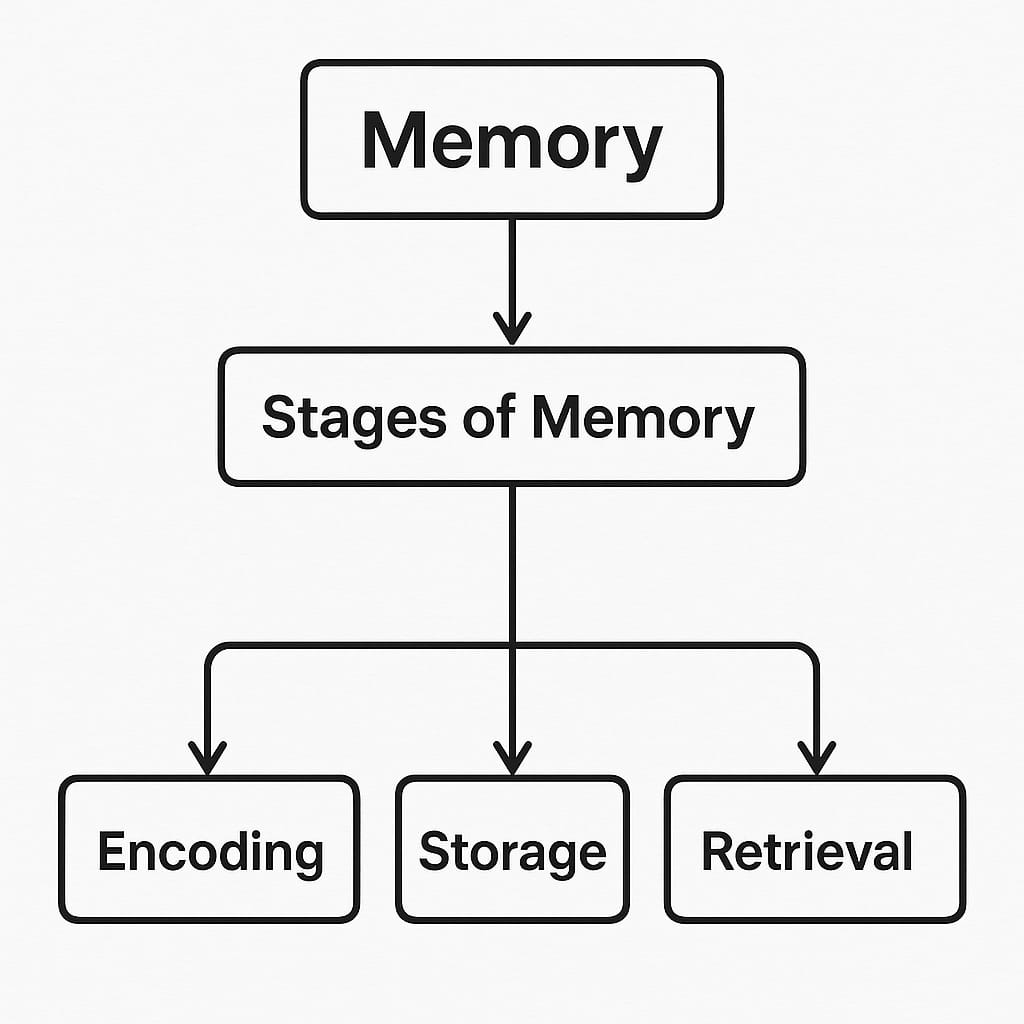
a.Encoding.
Encoding is the process of converting information into a form that can be stored in the brain. It is like typing on a key- the data gets recorded into the system in memory.
There are different types of encoding:
- Visual (Sight)
- Acoustic (Sound)
- Semantic (Meaning based)
b.Storage.
Once encoded,the data is stored for short or long periods. This involves retaining the information over time.
There are three major levels of stages:
- Sensory Memory (less than a one second)
- Short – Term Memory (15-30 seconds)
- Long – Term Memory (indefinitely)
c.Retrieval.
Retrieval is accessing the stored information when needed – like opening a saved file. Effective retrieval depends on how well encoding and storage were done.
Types of Memory in Psychology.
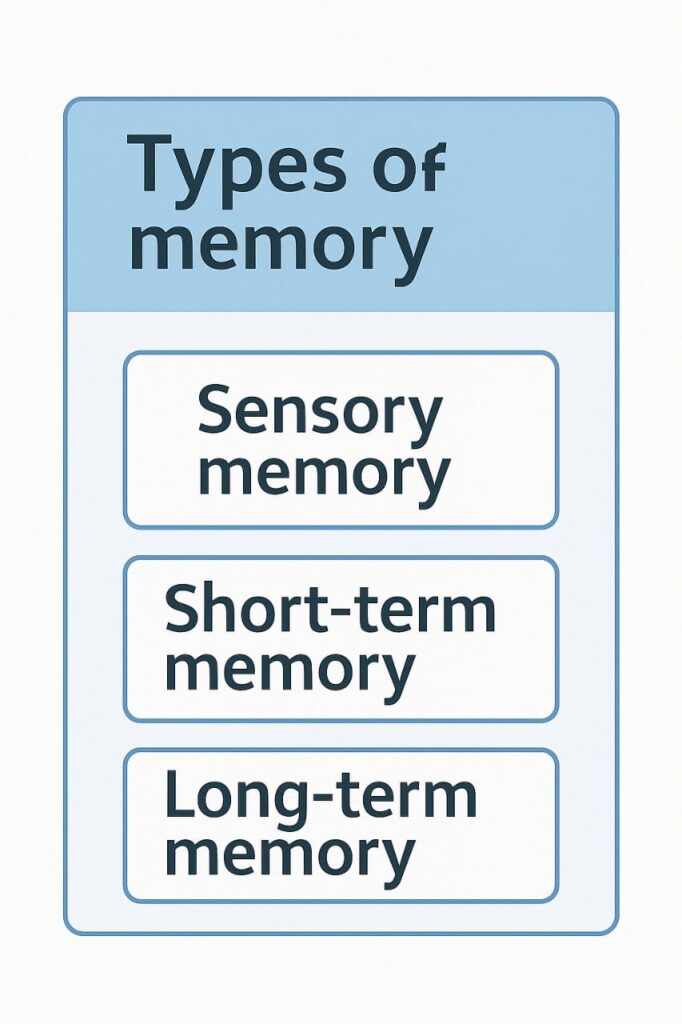
There are 3 types of Memory in Psychology Based on Duration:
1. Sensory Memory in Psychology
Sensory Memory in Psychology is the first types of memory that holds information from the senses ( like sight, sound,touch) for a very short time – usually less than one second. It acts as a brief storage system that allows our brain to decide what to focus on psychology.
- very Short -term memory
- Stores information from senses (sight, sound)
- Example:- Remembering the last frame of a video for a splict second.
Types of sensory Memory in Psychology
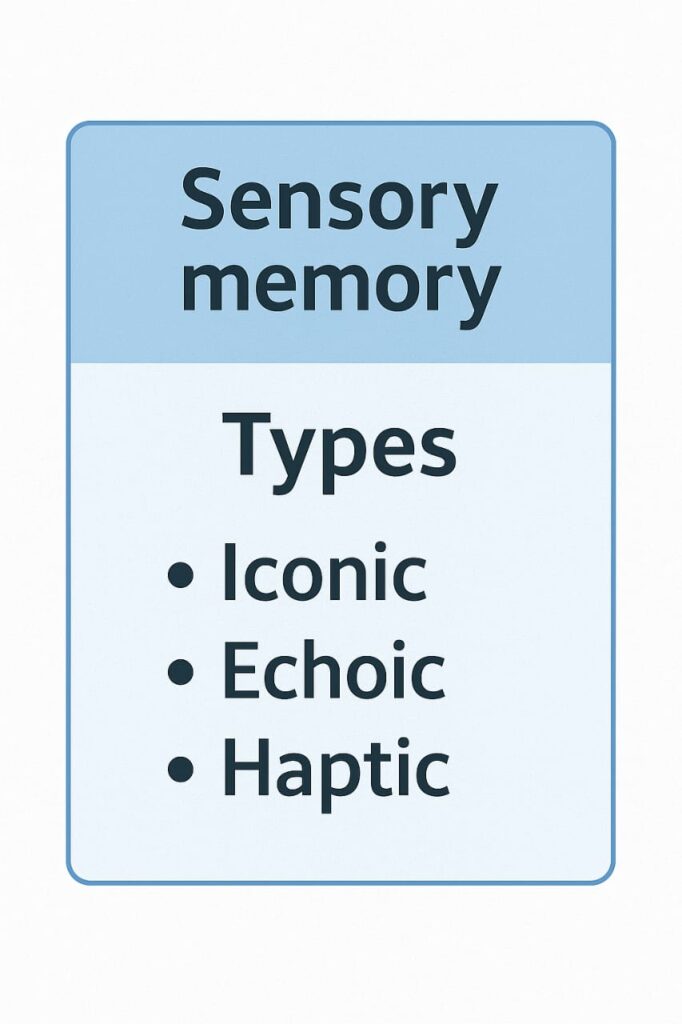
i. Iconic Memory (Visual Memory)
- What it does:- Stores information we see like colors, shapes or objects.
- Duration:- Less than one second .
- Example:- When you see a picture and close your eyes, you can briefly remember what you saw that’s iconic Memory.
ii. Echoic Memory (Auditory Memory)
- What it does :-Stores sounds we hear.
- Duration:- 3 to 4 seconds.
- Example:- If someone says something and you ask, “what?” – but then answer it yourself without them repeating – you used echoic Memory.
iii. Haptic Memory ( Touch Memory)
- What it does:- Stores information through touch like texture or pressure.
- Duration:- About 2 Seconds.
- Example:- when you Touch hot water and quickly pull your hand away, the memory of heat is stored in haptic Memory.
It helps us quickly react to things around us , like moving out of the way if a ball is coming towards us or recognising a voice in a crowd.
2. Short - Term Memory (STM) in Psychology
Short-Term Memory (STM) in Psychology is the second stage of memory in the information processing model, coming after sensory memory and before long-term memory. STM acts like a mental workspace where information is temporarily held and processed. It allows us to hold small amounts of information for a brief duration, usually around 15 to 30 seconds.
- Also known as “working memory”
- Limited capacity 7 ± 2 items (between 5 to 9 items)
- Duration 15 – 30 seconds
- Involves conscious processing
Example:- Recalling a phone number you just heard
- STM can hold about 7 ± 2 items (between 5 to 9 items), as suggested by George Miller.
- Example: If someone tells you a phone number like 9876543210, you can remember it for a short time if you repeat it.
- Without active rehearsal, the information in STM fades quickly within 15–30 seconds.
- Example: You hear someone’s name at a party and forget it moments later if you don’t focus on it.
- STM primarily uses acoustic encoding (based on sound).
- That’s why we often repeat things in our mind (like a number) to remember them.
- Repeating information (mentally or aloud) helps it stay in STM and may transfer it to long-term memory.
- Example: Repeating a definition several times to remember it for a test.
- Chunking helps increase capacity by grouping information into meaningful units.
- Example: Remembering a number sequence 1 9 4 7 2 0 0 1 as “1947” and “2001” (important years) instead of 8 separate digits.
STM vs Working Memory in Psychology:-
- Some researchers use these terms interchangeably in memory, but working memory is considered a more active version of STM, used for mental tasks like problem-solving or mental math.
- STM is more about holding, while working memory also involves manipulating information.
Pathways from STM in Psychology:-
- If rehearsed or encoded properly in memory, information from STM moves to Long-Term Memory (LTM).
- If ignored, the information decays or is displaced by new incoming data.
3. Long - Term Memory (LTM) in Psychology
Long – Term Memory in Psychology refers to the system responsible for storing information over extended periods from minutes to an entire lifetime. Unlike STM , which is limited in capacity and duration, LTM has virtually unlimited capacity and can store vast amounts of information for a very long time.
- Unlimited capacity
- Stores information for a lifetime
- Divided into Explicit and Implicit memory :
i. Explicit (Declarative) Memory
- Involves conscious recall
- Two types
- Episodic Memory:- Personal Experience (e.g., first day of School)
- Semantic Memory:- Facts and Concepts (e.g., Capital of India)
ii. Implicit (Non - Declarative) Memory
- Unconscious and automatic
- Includes:
- Procedural Memory (e.g.,riding a bike)
- Priming and Conditioned Responses so we learned associated between stimulus. (e.g,. A dog salivating when it hears a bell after repeated association with food).
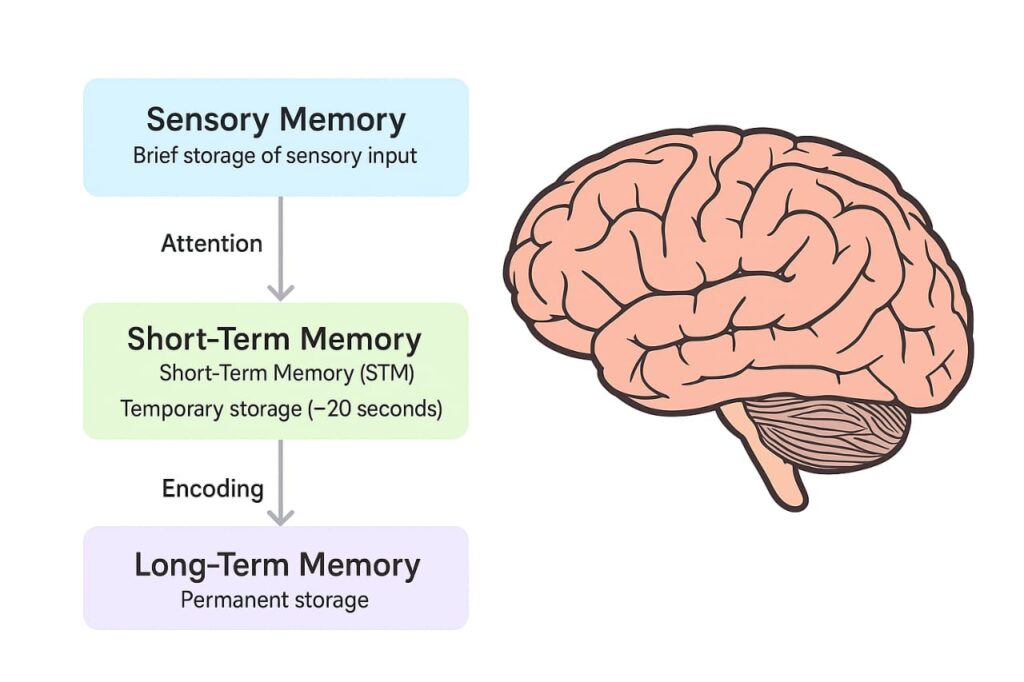
Working Memory in Psychology
Working memory in Psychology is a form of short-term memory that not only holds information temporarily but also allows you to actively process and manipulate it. It acts as a mental “workspace” where you perform cognitive tasks like reasoning, decision-making, and problem-solving in psychology.
Often described by Miller’s Law (7 ± 2 items), this means you can typically hold between 5 to 9 chunks of information at once.
Unlike simple storage, working memory lets you rearrange, update, and use information. For instance, when you mentally solve an arithmetic problem, you’re using working memory to hold and manipulate the numbers.
- Central Executive:- Directs attention and coordinates the other components.
- Phonological Loop:- Handles verbal information (e.g., remembering a phone number).
- Visuospatial Sketchpad:- Manages visual and spatial data (e.g., navigating a route).
- Episodic Buffer:- Integrates information across domains and links to long-term memory.
Example:-Imagine you’re reading a complex paragraph. Your working memory holds the beginning of the sentence while you read the end to understand its full meaning. Another example is doing mental math: if you’re solving “23 + 47,” you temporarily hold the numbers and add them in your mind before giving the answer.
Prospective Memory in Psychology
Prospective memory in Psychology is the ability to remember to perform an action or recall a planned intention at some point in the future. It is a type of long-term memory that is crucial for daily life, ensuring that we can carry out our intended tasks.
Unlike working memory, which deals with the present, prospective memory is all about “remembering to remember.” It helps in planning future activities.
It relies on cues or triggers to activate the memory. These cues can be time-based, event-based, or activity-based:
- Time-based: ” Take your medicine at 8 PM.”
- Event-Based: “When you see the mail, check for a package.”
- Activity-Based: “After you finish breakfast, call your friend.”
Prospective memory in psychology sometimes draws on episodic memory since it often relates to personal plans and events.
Consider a scenario where you need to remember a meeting at 3 PM. Even if you’re busy working on a project, a time cue (a clock or a reminder on your phone) prompts you to attend the meeting. Similarly, if you have an appointment to call someone after dinner, the completion of dinner (an event-based cue) triggers the memory to place the call.
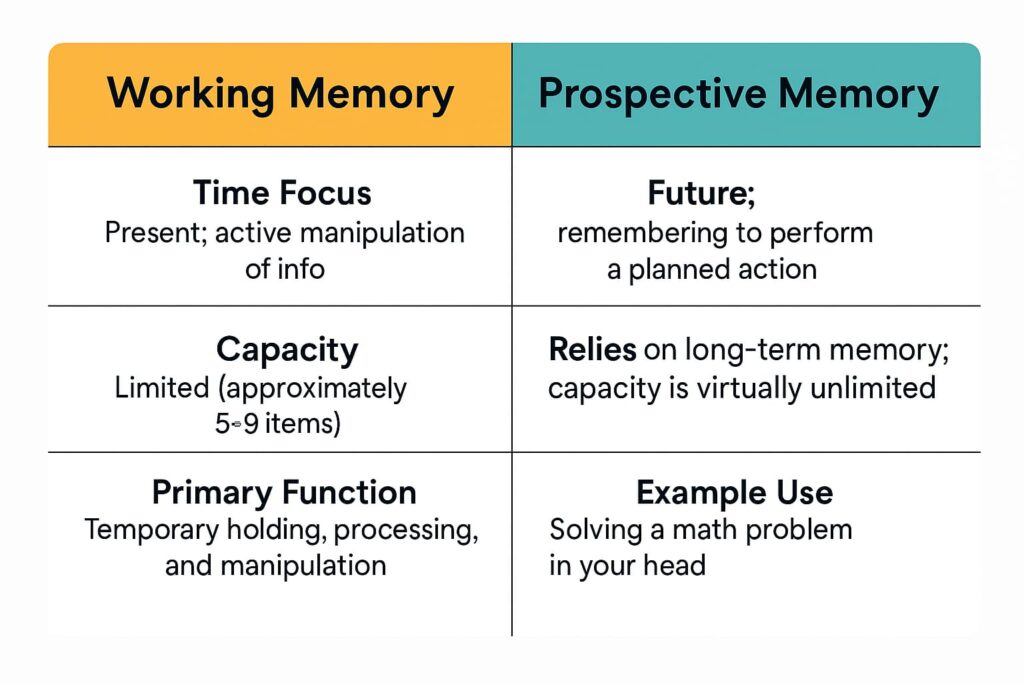
Both memory types play vital roles: Working memory helps in psychology us manage and process our immediate tasks, while prospective memory ensures that we fulfill our future obligations and daily routines. Understanding both systems is key to grasping how our mind works and how we can improve cognitive functions in everyday life.
Models of Memory in Psychology :-
There are three major models you need to understand:
1. Multi - Store memory in psychology ( Atkinson & Shiffrin - 1968)
This is the most well-known model, sometimes called the modal model.
Key Idea:
Memory is like a system with three separate stores:
- Sensory Memory
- Short-Term Memory (STM)
- Long-Term Memory (LTM)
Process Flow:
Stimulus (info from environment) → Sensory Memory → (via Attention) → STM → (via Rehearsal) → LTM
Example:
Imagine you’re watching a movie trailer:
- You see and hear it → goes into Sensory Memory
- You focus on it → moves into Short-Term Memory
- You keep thinking about it or repeat it in your mind → moves into Long-Term Memory
Strengths:
- Clear stages
- Influential and easy to understand
Limitations:
- STM is too simple — it doesn’t explain multitasking
- LTM doesn’t explain different types (like procedural vs episodic)
2. Working Memory Model memory in psychology ( Baddeley & Hitch - 1974)
This replaces STM with a more active, flexible system.
Key Idea:
Short-term memory isn’t just a box — it’s a system with different parts that work together.
Components:
1. Central Executive (the boss – controls attention)
2. Phonological Loop (handles sound & language)
3. Visuospatial Sketchpad (handles visual and spatial info)
4. Episodic Buffer (integrates info into episodes, links with LTM)
Example:
Imagine solving a math word problem:
- You read the question → phonological loop
- You visualize the numbers on paper → visuospatial sketchpad
- You decide what steps to take → central executive
- You recall a method you learned → episodic buffer linking to LTM
Strengths:
- Explains multitasking
- Realistic and detailed
Limitations:
- Hard to test “central executive” directly
- A bit complex
3. Levels of Processing Model memory in psychology ( Craik & Lockhart - 1972)
This model challenges the idea of separate “stores.”
Instead, it focuses on how deeply you process information.
Key Idea:
- Memory depends on how deeply you think about something:
- Shallow processing → surface-level (e.g., font or sound)
- Deep processing → meaning-based (e.g., making connections)
Example:
You’re trying to remember the word “elephant”:
Shallow: “It’s written in bold.” → you’ll forget it soon.
Deep: “It’s a large animal I saw at the zoo last summer.” → stronger memory.
Strengths:
- Explains why some memories are stronger than others
- Encourages meaningful learning
Limitations:
- Hard to measure “depth”
- Doesn’t explain me
- mory structure (like STM vs LTM)
How Memory in psychology the brain:-
1. Encoding – Taking in Information
When you experience something (like seeing a picture or hearing a sound), your brain receives this information through the sensory cortex. This step is called encoding — it’s like writing a note to remember later.
2. Storage – Holding the Information
Once encoded, your brain stores the information so you don’t forget it immediately. The memory stays in your brain over time — ready to be used later.
3. Consolidation – Making the Memory Strong
Your brain then makes the memory stable. This process happens mostly in the hippocampus, prefrontal cortex (PFC), neocortex, and cerebellum. It helps move information from short-term to long-term memory.
4. Retrieval – Getting the Memory Back
When you need to remember something, your brain retrieves the information. This happens in the prefrontal cortex and hippocampus — like opening a saved file on your computer.
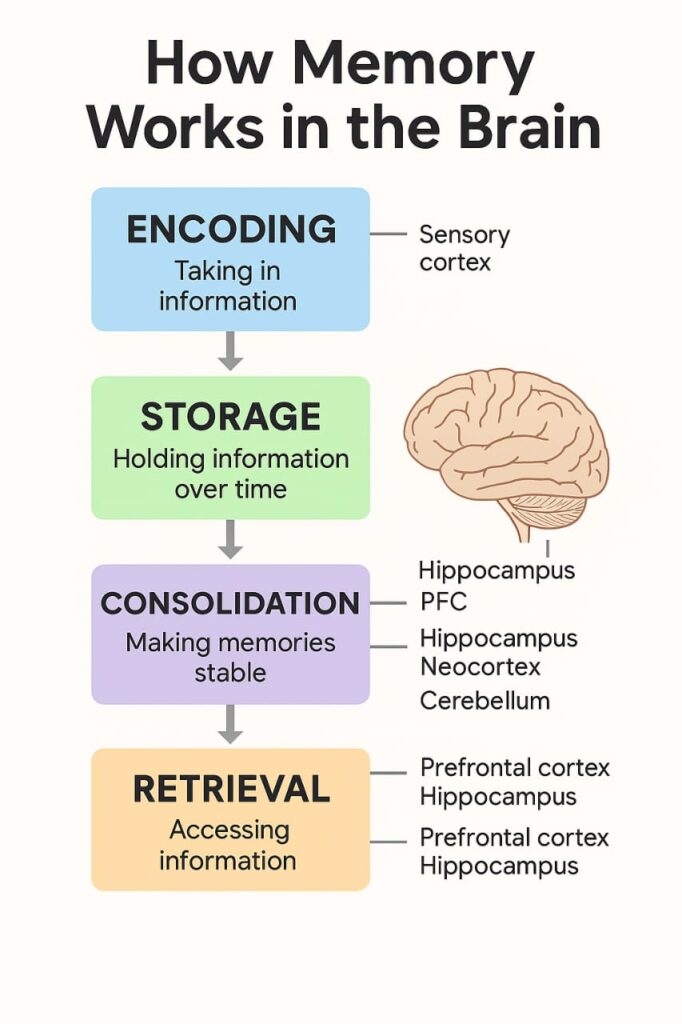
How to Improve Memory in Psychology:-
1. Pay full attention
“Eliminate distractions and focus on the information.”
- Why it matters: If you’re not focused, your brain doesn’t take in the information properly.
Example: While studying, keep your phone on silent and sit somewhere quiet.
2. Use repetition & spaced practice
“Review the information regularly over time.”
- Why it matters: Our brain needs time to absorb information. Repeating it helps you remember.
Example:- Instead of reading all in one night, study a little every day for a week.
3. Make it meaningful
“Connect new information to what you already know.”
- Why it matters: Your brain remembers better when it links new ideas with old ones.
Example:-If you’re learning about “encoding,” think of it like saving a file on a computer.
4. Use visuals & mind maps
“Represent information with images and diagrams.”
- Why it matters: Your brain understands and remembers pictures faster than plain words.
Example: – Draw a diagram of the memory model instead of just writing about it.
5. Sleep well
“Get 7–9 hours of restful sleep per night.”
- Why it matters: While you sleep, your brain strengthens and organizes memories.
Example:- Don’t study all night — study early, then get good sleep.
6. Practice retrieval
Test yourself to strengthen memory recall.”
- Why it matters: The more you try to recall, the stronger the memory becomes
Example:- After reading a chapter, close the book and write everything you remember.
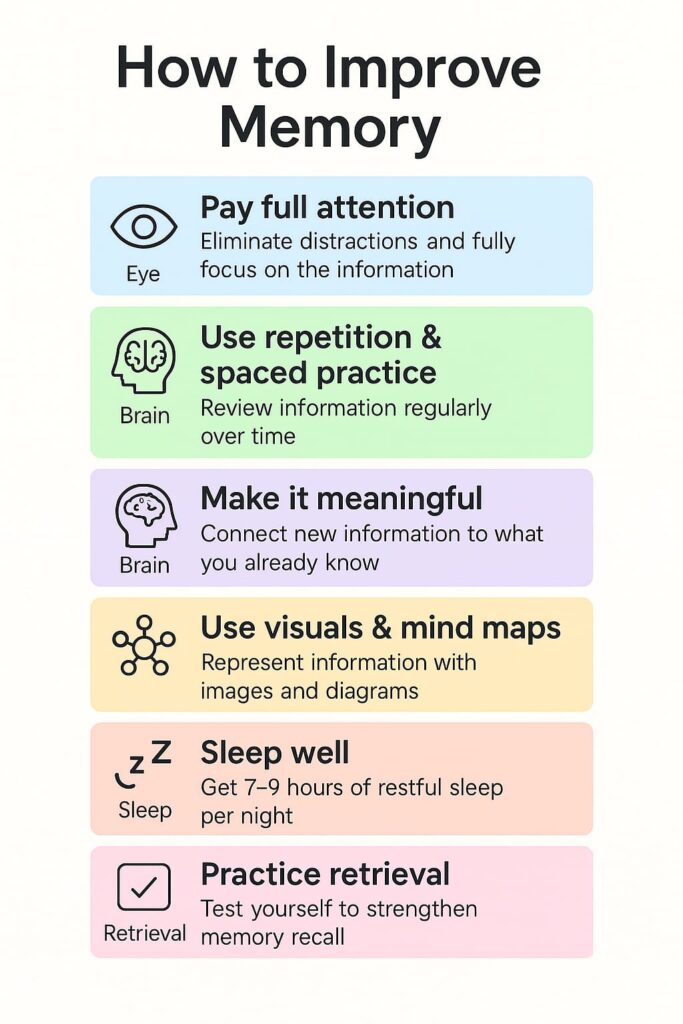
Real life Applications of Memory in Psychology
1. Education and learning:-
Application: Students use memory to remember facts, formulas, and concepts.
Example: When a student recalls the Pythagorean theorem during a math test, they’re using long-term memory.
Type of Memory in Psychology: Semantic Memory (general knowledge), Working Memory.
2. Driving a Car
Application: Remembering road signs, traffic rules, and motor skills.
Example: After months of practice, you can drive without consciously thinking about every step. This is procedural memory at work.
Type of Memory in psychology: Procedural Memory (a type of implicit memory).
3. Using Language
Application: Speaking, reading, and writing depend on stored vocabulary and grammar rules.
Example: When you hold a conversation, your brain retrieves thousands of words instantly.
Type of Memory in psychology: Semantic and Working Memory
4. Remembering Appointments and Tasks
Application: Keeping track of daily responsibilities.
Example: You remember to take medicine at 8 PM. This is an example of prospective memory.
Type of Memory in Psychology: Prospective Memory.
5. Social Interactions
Application: Recognizing people, remembering names, and shared experiences.
Example: You remember a friend’s birthday and what you did last year.
Type of Memory in psychology: Episodic Memory (personal experiences).
6. Making Decisions
Application: Drawing on past experiences to make smart choices.
Example: Choosing not to touch a hot pan because you remember the pain from before.
Type of Memory in Psychology: Episodic and Semantic Memory.
7. Occupational Skills
Application: Many jobs rely heavily on memory.
Example: A doctor remembering a treatment plan or a chef recalling a recipe.
Type of Memory in Psychology: Long-Term Memory (semantic + procedural).
8. Creativity and Problem solving
Application: Recalling past knowledge to build new ideas.
Example: An artist remembering different styles to create something original.
Type of Memory in Psychology: Semantic and Working Memory.
